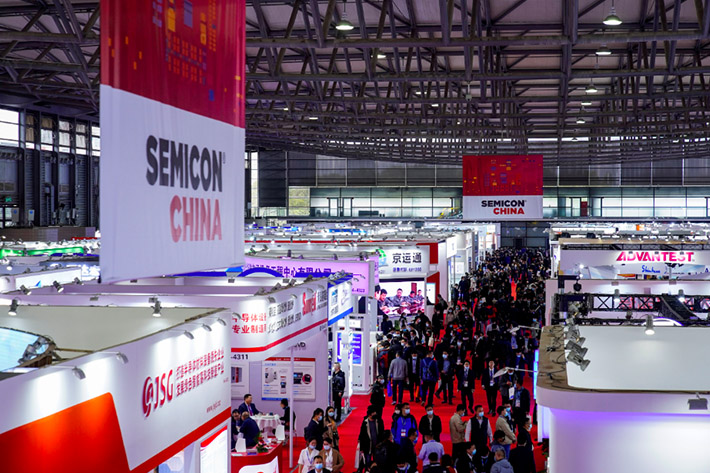As more than a thousand semiconductor firms descended upon the Semicon China exhibition in Shanghai, Beijing’s push for self-sufficiency in the chip supply chain took centre stage at the key annual fair.
From calling on buyers to choose domestic suppliers, to pitching their products as direct competitors to foreign equipment — Chinese chip firms pulled out all the stops to spur interest
“‘Buy local’ and getting supply chains out of US control was a clear focus of many at the show,” said Cameron Johnson, a Shanghai-based senior partner at consultancy Tidalwave Solutions, who has attended Semicon China since 2016.
Also on AF: China’s SMIC May Have Breached US Curbs With Huawei Chip
The message was plastered across booths and marketing materials of a variety of companies, from chip equipment makers to materials producers. These included Vel-Tec Semiconductor, a Kunshan-based firm that makes photoresist coating equipment, and Shenzhen-listed Jingsheng, which manufactures machines used for processing silicon wafers.
Over a dozen Chinese exhibitors at the show said their products could be used as replacement for foreign-made ones.
Staff from foreign firms that were represented said that while there was still a gap in quality and efficacy, Chinese rivals were quickly catching up.
Gaining ground
A Beijing-based salesperson, surnamed Ye, representing a Japanese company that makes materials used in chipmaking, said Chinese rivals are rapidly closing the gap in material areas that do not require cutting-edge technology.
“Formulating material prescriptions is a major entry barrier, but Chinese companies are learning quickly and overcoming this hurdle,” he said.
This is because more manufacturing facilities are willing to use materials prescribed by Chinese firms, a trend that has certainly been accelerated by US sanctions, he said.
China is also pouring in billions in state-subsidies to accelerate domestic chipmaking. The push is part of the authoritarian Xi Jinping government’s Made in China campaign that calls to develop 70% semiconductor self-sufficiency by 2025.
A key area of focus for China is developing native chipmaking equipment — with US sanctions cutting off the country from global equipment leaders such as Dutch giant ASML.
State-backed Naura Technology Group, for instance, claimed at the exhibition it now had machines that could produce next-generation 7-nanometre chips for smartphones, according to a report by Nikkei Asia.
The report said Naura is believed to be working with China’s largest foundry Semiconductor Manufacturing International Corporation (SMIC), which was said to behind the sanctions-defying 7nm chips in Huawei Technologies Mate 60 smartphone series.
State-owned SMIC and Huawei are now gearing up to mass-produce 5nm chips for smartphones. If successful, the firms also plan to use the technology to produce Huawei’s Nvidia-rival Ascend AI chips in 5nm.
Both of those firms, however, gave the exhibition a miss.
View this post on Instagram
Beating foreign rivals
An executive at the fair also told Nikkei that China was aiming to account for a 70% share of global chipmaking equipment production by 2035.
Ye, who said he deals with many Chinese semiconductor equipment makers, said domestic companies were gaining more orders against foreign rivals in the equipment sector.
Naura’s sales estimates for 2023 are up more than 40% on the year, according to Nikkei. The company also estimates net profit to grow at more 50% for the period.
An attending salesperson from a Shenzhen-based firm that makes testing equipment used throughout all processes of chipmaking said Chinese firms had cost advantages and his firm’s highest-end product is now being sold at just one-third of the price of its Japanese rivals.
Because of the cost advantage, manufacturing facilities and clients tend to prioritise domestic firms for production lines in newly opened plants, he said, asking not to be named as he has been told not to speak to media.
In some cases, they even replace foreign equipment with domestic alternatives in older production lines, he added.
Analysts, however, say that big gaps still remain for China’s chip industry to catch up to its global rivals, the most pressing being a lack of exposure to advanced chipmaking facilities.
Even so, China is expected to lead the world in growing its chip production capacity this year, with plans to start operations at 18 new fabs. SEMI estimates China will account for the world’s largest share of chip production by 2030.
US firms missing
US semiconductor giants, who prior to US-sanctions, thronged the exhibition in the world’s biggest chip market were largely missing this year.
Few US firms turned up at the event that attracted 1,100 exhibitors and large crowds of visitors. California-based chip tools firm KLA was the only major US semiconductor firm to attend Semicon China, according to a report by the South China Morning Post.
US chip firms Applied Materials and Lam Research sponsored the exhibition for a second-consecutive term but had no physical presence, the report added.
Netherlands-based ASML, which recently had its licences to ship some chipmaking lithography machines to China revoked, was also absent. China was ASML’s second-largest market in 2023, accounting for more than 26% of its sales.
Meanwhile, key Japanese chip tool makers Tokyo Electron and Canon did attend the fair, as did several South Korean, and Taiwanese companies.
#SEMICON China✨, the world’s largest and highest-profile annual #semiconductor industry event🤝, is underway at Shanghai New International Expo Centre (#SNIEC) through this Friday.
Spanning 90,000sqm in exhibition area, the expo features 1,100 exhibitors and 4,500 booths,… pic.twitter.com/24fjlCbtuF
— Shanghai Let’s meet (@ShLetsMeet) March 21, 2024
- Reuters, with additional inputs from Vishakha Saxena
Also read:
Global Chip Sector ‘Can Never Return to its Pre-Covid Set-up’
Slower Nvidia Chip Out in Q2 But China Firms ‘Don’t Want It’
New Huawei Laptop Fuels Talk of Sanctions-Beating 5nm Chip
Nvidia’s New AI Chip for China Priced Close to Huawei Alternative
US Curbs Set Off Sales, Tech Boom for China Chip Equipment Firms
Threat of More Chip Curbs Spurs Warnings on China Innovation
China Firms Rush to Poach Nvidia Clients With AI Chip Offerings
























